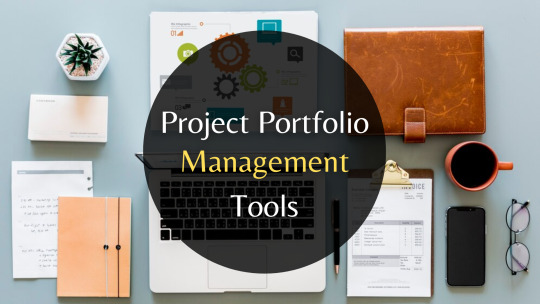#Project Portfolio Management
Explore tagged Tumblr posts
Text
Maximizing Efficiency with Project Portfolio Management Software

In today’s fast-paced business landscape, organizations handle multiple projects simultaneously, often facing challenges related to resource allocation, project prioritization, and operational inefficiencies. Managing these complexities manually or with outdated tools can lead to missed deadlines, budget overruns, and misaligned business goals. This is where Project Portfolio Management (PPM) software becomes a game-changer. By leveraging PPM software, businesses can streamline processes, optimize resources, and make data-driven decisions that enhance overall efficiency.
Understanding Project Portfolio Management Software
Project Portfolio Management (PPM) software is a centralized solution that enables organizations to manage multiple projects, assess risks, track progress, and align projects with strategic objectives. Unlike traditional project management tools that focus on individual tasks, PPM software provides a holistic view of the entire project portfolio, helping businesses optimize their workflows and improve efficiency.
How PPM Software Boosts Efficiency
1. Centralized Project Visibility
One of the biggest challenges in project management is lack of visibility into project statuses, timelines, and dependencies. PPM software provides a unified dashboard where project managers can view real-time updates, monitor progress, and track key performance metrics. This ensures that all stakeholders stay informed, reducing miscommunication and delays.
2. Intelligent Resource Allocation
Effective resource management is critical for maximizing efficiency. PPM software helps optimize resource allocation by analyzing team availability, skill sets, and workload distribution. It prevents overallocation, reduces idle time, and ensures that the right resources are assigned to the right projects at the right time.
3. Automated Workflows and Task Management
Manual workflows slow down project execution and increase the risk of errors. PPM software automates repetitive tasks, such as approvals, scheduling, and reporting. This not only accelerates project completion but also ensures consistency in processes, reducing human error and administrative overhead.
4. Real-Time Performance Tracking and Reporting
Tracking performance manually can be time-consuming and inaccurate. PPM software generates real-time reports and analytics, allowing managers to assess project health, track budgets, and measure productivity. These insights enable businesses to make informed decisions and implement corrective actions before issues escalate.
5. Proactive Risk Management
Unforeseen risks can derail projects and affect overall efficiency. PPM software identifies potential risks through predictive analytics and historical data, helping businesses mitigate issues before they impact project timelines and costs. With automated alerts and risk assessment tools, teams can proactively address challenges and stay on course.
6. Seamless Collaboration Across Teams
Cross-functional collaboration is essential for project success, especially in large organizations. PPM software provides collaboration tools, shared dashboards, and real-time document sharing, ensuring seamless communication among teams, vendors, and stakeholders. This reduces bottlenecks, enhances coordination, and accelerates project delivery.
7. Strategic Project Prioritization
Not all projects contribute equally to business success. PPM software helps organizations prioritize projects based on strategic value, ROI, and available resources. By focusing on high-impact projects, businesses can optimize efficiency and drive long-term growth.
Key Considerations When Choosing a PPM Solution
To maximize efficiency, organizations should choose a PPM software that offers:
Scalability: Can it support growing project demands?
Integration: Does it integrate with existing tools (ERP, CRM, HRMS)?
Customization: Can workflows be tailored to business needs?
User-Friendly Interface: Is it intuitive for teams?
Advanced Analytics: Does it offer real-time reporting and insights?
Conclusion
In an era where efficiency determines success, Project Portfolio Management (PPM) software is no longer optional—it is a necessity. By automating workflows, optimizing resources, and improving project visibility, PPM software helps organizations achieve faster project deliveries, reduce costs, and align projects with business objectives.
0 notes
Text
#project portfolio management#project portfolio management definition#project management#portfolio management#PPM
1 note
·
View note
Text

Unlock significant cost savings with effective project portfolio management. Investing in proven practices guided by project management consulting services can optimise resource allocation, reduce waste, and enhance outcomes—leading to lower costs and improved team communication, product quality, and customer satisfaction.
0 notes
Text
Maximize Efficiency with Leading PPM Software Solutions

In today’s fast-paced business environment, efficiency is not just a goal; it’s a necessity. Project Portfolio Management (PPM) software solutions have become indispensable tools for organizations aiming to streamline operations, optimize resources, and enhance productivity. By integrating PPM software into your business processes, you can significantly boost efficiency and drive better project outcomes. Here’s how leading PPM software solutions can help you achieve these goals.
Centralized Project Oversight
PPM software provides a centralized platform for managing multiple projects simultaneously. Tools like Microsoft Project, Planview, and Smartsheet offer comprehensive dashboards that give managers real-time insights into project statuses, timelines, and resource allocation. This centralized oversight ensures that all projects are aligned with strategic objectives and are progressing as planned.
Optimal Resource Allocation
Effective resource management is crucial for maximizing efficiency. PPM software like Wrike and Monday.com excels in resource allocation by offering tools to plan, track, and optimize the use of resources across projects. These platforms help ensure that the right resources are assigned to the right tasks at the right time, preventing overallocation and underutilization.
Enhanced Collaboration
Collaboration is key to efficient project execution. Leading PPM software solutions provide integrated communication tools that facilitate seamless collaboration among team members. Platforms such as Asana and Trello offer features like shared dashboards, document management, and real-time chat, ensuring that all team members are on the same page and can easily share information and updates.
Data-Driven Decisions
PPM software empowers organizations to make data-driven decisions by providing robust analytics and reporting features. Tools like Tableau and Microsoft Power BI integrate with PPM solutions to deliver actionable insights into project performance. Managers can use these insights to identify trends, forecast future performance, and make informed decisions that enhance efficiency.
Risk Management
Every project comes with inherent risks. PPM software like Clarizen and Planview helps identify, assess, and mitigate these risks, ensuring that projects stay on track. By proactively managing risks, businesses can avoid potential disruptions and ensure smooth project execution.
Conclusion
Maximizing efficiency in project management is essential for staying competitive in today’s business landscape. Leading PPM software solutions offer the tools needed to centralize project oversight, optimize resource allocation, enhance collaboration, enable data-driven decisions, and manage risks effectively. By integrating these solutions into your operations, you can drive better project outcomes, boost productivity, and achieve your strategic goals more efficiently. Embrace PPM software to transform your business operations and stay ahead in the competitive market.
0 notes
Text
Unleashing Success with Project Portfolio Management: A Comprehensive Guide
https://ciolookleaders.com/wp-content/uploads/2024/05/1-Unleashing-Success-with-Project-Portfolio-Management_-A-Comprehensive-Guide.jpg
In today’s dynamic business landscape, organizations are constantly striving to stay ahead of the curve. With a plethora of projects in the pipeline, managing them efficiently becomes paramount. This is where Project Portfolio Management (PPM) steps in as a game-changer. In this comprehensive guide, we delve into the intricacies of PPM, its significance, and how it can empower organizations to achieve their strategic objectives seamlessly.
Understanding Project Portfolio Management
Project Portfolio Management, often abbreviated as PPM, is a strategic approach that enables organizations to effectively manage and prioritize a portfolio of projects to achieve their business objectives. It involves the centralized management of projects, programs, and other initiatives to align with the organization’s goals and objectives.
At its core, PPM focuses on optimizing resource allocation, mitigating risks, and maximizing returns on investment (ROI) across the entire project portfolio. By employing PPM practices, organizations can make informed decisions, allocate resources judiciously, and ensure that projects are aligned with the overarching business strategy.
Key Components of Project Portfolio Management
1. Portfolio Governance

Governance plays a pivotal role in PPM by establishing policies, processes, and procedures for decision-making and oversight. It involves defining roles and responsibilities, establishing clear communication channels, and ensuring transparency throughout the project lifecycle.
2. Strategic Alignment
PPM aims to align projects with the organization’s strategic objectives to ensure that resources are allocated to initiatives that contribute the most value. By prioritizing projects based on their alignment with strategic goals, organizations can focus their efforts on initiatives that drive business growth and competitive advantage.
3. Resource Management
Effective resource management is essential for optimizing resource utilization and avoiding overallocation or underutilization of resources. PPM provides visibility into resource availability, skills, and capacity, allowing organizations to allocate resources efficiently and avoid bottlenecks.
4. Risk Management
Risk management is integral to PPM as it helps identify, assess, and mitigate risks associated with projects. By proactively addressing potential risks, organizations can minimize disruptions and enhance the likelihood of project success.
5. Performance Measurement
PPM involves tracking and evaluating the performance of projects against predefined metrics and KPIs. By monitoring key performance indicators, organizations can identify areas for improvement, make data-driven decisions, and ensure that projects are delivering the intended outcomes.
6. Communication Management
Effective communication is vital for the success of PPM initiatives. Establishing clear communication channels among stakeholders ensures that everyone is informed about project status, changes, and important decisions. Regular communication fosters collaboration, alignment, and transparency throughout the project lifecycle.
The Benefits of Project Portfolio Management
Implementing Project Portfolio Management offers a myriad of benefits to organizations across industries:
1. Improved Decision-Making
PPM provides stakeholders with actionable insights and data-driven analytics to make informed decisions about project selection, prioritization, and resource allocation.
2. Enhanced Resource Utilization
By centralizing resource management, PPM enables organizations to optimize resource allocation, improve productivity, and reduce costs.
3. Alignment with Strategic Goals

PPM ensures that projects are aligned with the organization’s strategic objectives, allowing businesses to focus their efforts on initiatives that drive long-term growth and success.
4. Reduced Risk
Through proactive risk management practices, PPM helps organizations identify and mitigate risks early in the project lifecycle, minimizing potential disruptions and ensuring project success.
5. Increased ROI
By prioritizing projects based on their potential return on investment, PPM helps organizations maximize the value generated from their project portfolio, resulting in increased ROI.
6. Stakeholder Engagement
PPM promotes stakeholder engagement by involving key stakeholders in the decision-making process and keeping them informed about project progress and outcomes. Engaged stakeholders provide valuable insights, support, and buy-in, which enhances project success and fosters a culture of collaboration and accountability.
Best Practices for Implementing Project Portfolio Management
While the benefits of PPM are undeniable, successful implementation requires careful planning and execution. Here are some best practices to consider:
1. Define Clear Objectives
Clearly define the objectives and goals of your PPM initiative, ensuring alignment with the organization’s overall strategy and priorities.
2. Establish Governance Structure
Develop a robust governance structure with clearly defined roles, responsibilities, and decision-making processes to ensure accountability and transparency.
3. Prioritize Projects
Use criteria such as strategic alignment, resource requirements, and potential ROI to prioritize projects and allocate resources effectively.
4. Implement Robust Risk Management

Identify potential risks associated with projects and develop mitigation strategies to address them proactively.
5. Monitor and Evaluate Performance
Continuously monitor and evaluate the performance of projects against predefined metrics and KPIs to identify areas for improvement and make data-driven decisions.
6. Continuous Improvement
PPM is an iterative process that requires continuous improvement and refinement. Regularly review and evaluate the effectiveness of your PPM practices, identify areas for enhancement, and implement changes to optimize performance and drive continuous improvement. Embrace a culture of learning and adaptability to stay ahead in today’s rapidly evolving business landscape
Conclusion
In conclusion, Project Portfolio Management is a strategic approach that enables organizations to effectively manage and prioritize a portfolio of projects to achieve their business objectives. By aligning projects with strategic goals, optimizing resource allocation, and mitigating risks, PPM empowers organizations to drive growth, innovation, and competitive advantage.
As businesses continue to navigate complex and ever-changing market dynamics, the adoption of Project Portfolio Management is becoming increasingly crucial. By embracing PPM best practices and leveraging advanced tools and technologies, organizations can unleash the full potential of their project portfolio and pave the way for sustained success in the digital age.
Project Portfolio Management isn’t just about managing projects; it’s about transforming the way organizations operate, innovate, and thrive in today’s fast-paced business environment. Embrace the power of PPM and unlock new opportunities for growth, efficiency, and excellence in project management.
Also Read: Unlocking the Potential of Management Leadership for Tomorrow
0 notes
Text
Supercharge Your Portfolio: The Ultimate Guide To Project Portfolio Management Tools

The need for effective oversight and strategic alignment is paramount. Enter Project Portfolio Management tools (PPM) —a transformative arsenal designed to empower organizations in their quest for project success. These tools, equipped with advanced capabilities and robust features, serve as the compass guiding businesses through the complexities of project portfolios, enabling informed decision-making, resource optimization, and strategic alignment with overarching objectives.
As organizations grapple with an ever-expanding array of projects, varying in scope, scale, and strategic importance, the need for effective portfolio management has never been more pronounced. PPM tools offer a holistic approach to portfolio oversight, enabling stakeholders to gain visibility into project lifecycles, track performance metrics, and make data-driven decisions that drive project success and organizational growth.
Moreover, in an era defined by digital transformation and rapid technological advancement, the capabilities of PPM tools continue to evolve, ushering in a new era of efficiency and innovation. From predictive analytics and AI-driven insights to seamless integration with existing workflows and collaboration platforms, these tools empower organizations to adapt to change, seize opportunities, and stay ahead of the curve in an increasingly competitive landscape.
What Is Project Portfolio Management?
Project Portfolio Management (PPM) is a strategic approach used by organizations to effectively manage and prioritize a collection of projects or initiatives in alignment with their overall business objectives and constraints. Essentially, PPM involves making decisions about which projects to pursue, how to allocate resources across those projects, and how to monitor and control the portfolio to ensure that it delivers the desired outcomes.
At its core, PPM aims to optimize the organization's investment in projects by selecting and executing the right mix of projects that best support its strategic goals and deliver the highest value. This involves evaluating potential projects based on factors such as their alignment with business objectives, potential return on investment (ROI), resource requirements, risks, and dependencies.
Process Of Portfolio Management
Initiation And Planning
The portfolio management process begins with identifying the organization's strategic objectives and goals. This involves understanding the organization's mission, vision, and long-term strategy.
The current portfolio is assessed to determine its alignment with the organization's objectives, as well as its overall health and performance. This involves analyzing factors such as project status, resource utilization, risks, and returns.
Selection And Prioritization
Potential projects are identified that align with the portfolio strategy and contribute to the organization's objectives. This may involve generating project ideas, soliciting proposals, or evaluating existing project requests.
Each potential project is evaluated based on criteria such as strategic alignment, potential benefits, resource requirements, risks, and dependencies. Projects are then prioritized according to their perceived value and contribution to the portfolio's objectives.
Execution And Monitoring

Once projects are selected and prioritized, resources such as budget, personnel, and equipment are allocated to support their execution. Resource allocation decisions are guided by the portfolio strategy and priorities.
Project performance is monitored throughout the execution phase to ensure that projects are progressing according to plan. Key performance indicators (KPIs) are tracked, and deviations from the plan are identified and addressed in a timely manner.
Review And Adaptation
Regular reviews of the portfolio are conducted to assess performance against objectives and KPIs. This involves analyzing project outcomes, identifying lessons learned, and evaluating the overall effectiveness of the portfolio strategy.
Based on the performance review and changing business conditions, adjustments may be made to the portfolio strategy. This may involve reallocating resources, reprioritizing projects, or adding/removing projects from the portfolio to better align with organizational objectives.
Is Using Portfolio Management Software Worth It For Business?
Using portfolio management software can indeed be highly beneficial for businesses, offering a range of advantages that make it well worth the investment. Firstly, such monitoring software provides organizations with a centralized platform for managing their project portfolios, enabling them to streamline processes, enhance visibility, and improve decision-making.
By consolidating project data, resources, and performance metrics in one place, portfolio management software empowers stakeholders to gain real-time insights into the health and progress of their portfolios, facilitating proactive adjustments and optimizations as needed.
Moreover, portfolio management software often comes equipped with advanced analytics and reporting capabilities, allowing organizations to analyze trends, identify patterns, and extract valuable insights from their portfolio data. This enables informed decision-making, risk management, and resource allocation, ultimately driving better project outcomes and organizational performance. Also Watch: Leading Employee Engagement and Workforce Productivity Tool
youtube
Final Words!
As we draw this journey to a close, it becomes evident that in today's complex business landscape, where organizations juggle myriad projects, initiatives, and priorities, the need for effective portfolio management has never been greater.
The Project Portfolio Management tools serve as the compass guiding organizations through the complexities of project portfolios, empowering them to make data-driven decisions, allocate resources strategically, and align project investments with overarching business objectives.
From initiation and planning to execution, monitoring, and adaptation, the portfolio management process unfolds as a dynamic cycle of continuous improvement and optimization. With the right PPM tools in place, organizations gain the visibility, agility, and control needed to navigate this cycle with confidence and clarity, driving better project outcomes and organizational performance.
#Project Portfolio#Management Tools#project portfolio management#portfolio management process#management software#Youtube
0 notes
Text
Project Portfolio Management: Balancing Priorities for Maximum Impact
Project Portfolio Management (PPM) stands as a pivotal component in modern business strategy, providing a framework for organizations to manage and prioritize their projects effectively. At its core, PPM is about aligning projects with an organization’s strategic objectives, ensuring that each project contributes meaningfully to the overarching goals of the business. This approach goes beyond…

View On WordPress
0 notes
Link
#adroit market research#project portfolio management#ppm industry 2020#ppm industry trends#ppm industry size
0 notes
Link
Increasing implementation of cloud-based solutions for the remote monitoring of projects drives the demand for project portfolio management market ...
#adroit market research#project portfolio management#ppm industry 2020#ppm industry trends#ppm industry size
0 notes
Text
i CANNOT wait for this semester to be over. 23 hours remain. God.
#im gonna do nothing on saturday.#literally i am just gonna crochet madly and rewatch the terror for the first time since August#i need this. i need it.#gonna make amigurumi rats and an opossum for my friend. and nothing else.#i am so close. just gonna touch up my mock teaching portfolio in all aspects and turn it in.#idk how i went from: reworking 2 old term papers. writing from scratch 5 statements of purpose. 1 personal statement. a CV. a resume.#a video essay.#a 10k paper. a digital project with research. a self assessment. three interviews for class. a mock syllabus. a lesson plan.#a teaching philosophy. two lectures and a final to proctor.#that was my ENTIRE to-do list 3 weeks ago. not counting the research and soundwalking in a game i had to do for that 10k paper.#idk how i went from ALL THAT. to this. in that little time. with a holiday in the middle.#how the FUCK did i do that. what the shit.#i need a massive break but what the hell. what.#like. idk. i was really proud of myself on Monday for finishing that big paper bc 10k is the longest paper I've written for school.#and i wrote it in A WEEK.#most of the work was compacted into 4 days. 4 DAYS.#i did most of tha phd app work in 12!! 12 fucking days!!#i have had an extremely productive 21 days. and I'm so proud of myself for managing all that shit.#but oh my god i am so hype to become one with my couch and do a hobby bc i havent done hobbies in............. at least a month.
4 notes
·
View notes
Text
hiii just a heads up that i will be going on another art hiatus soon! i'm about halfway through my semester which means my final projects are coming up soon AND i'm spending most of my free time cooking up another animated short film 👀 so please expect less art posts from me until mid-july. i will still be active on social media though & might update you on my progress!
#talks#art fight will be complicated oughgh but hopefully i'll manage to finish my short film by the end of june.#putting my heart and soul into a project for an ungraded class LOL but i'm mainly doing it for the experience and my portfolio
18 notes
·
View notes
Text
5 Common Crypto Investment Mistakes and How to Avoid Them.
With its potential for high returns comes equally high risk. New investors often find themselves making critical mistakes that can impact their financial health. We'll explore five common mistakes.
Investing in cryptocurrency can be both thrilling and daunting. With its potential for high returns comes equally high risk. New investors often find themselves making critical mistakes that can impact their financial health. Here, we’ll explore five common errors and provide in-depth guidance on how to avoid them. 1. Lack of Research and Due Diligence Mistake: Jumping into investments without…

View On WordPress
#Altcoin Investment#Altcoins#Avoid FOMO#Avoiding Crypto Scams#Beginner’s Guide to Crypto#Blockchain Technology#Crypto Community#Crypto Investment#Crypto Investment Strategy#Crypto News#Crypto Portfolio#Crypto Research Tips#Crypto Scams#Crypto Whitepapers#Cryptocurrency Investing#Cryptocurrency Red Flags#Dollar-Cost Averaging#Financial Advice#How to Spot Crypto Scams#Identifying Genuine Crypto Projects#Investing in Cryptocurrency#Investing Tips#Legitimate Crypto Projects#Meme Coins#Reputable Crypto Exchanges#Risk Management#Secure Investments#Token Distribution
2 notes
·
View notes
Text
woughh,,,,, busy,,,,,,,,,
#met with my internship people today and it was basically nonstop from there#i just finished taking care of my responsibilities for the day and i am now laying in bed#because i have another meeting at 7am tomorrow#grind doesn’t stop -/SMACKED#for real though i am being launched into action like a pumpkin from a trebuchet#i want to play videoed game so bad as a treat but i Really need to use my downtime tomorrow to do artwork things#because i need to make major progress on this project before the Real horrors start#right now it is just usual college stuff#readings and assignments and commutes and classes and zooms#but soon it becomes that and basically being an unpaid employee for 4 hours a day#and preparing an extensively vetted portfolio on top of that#it’s going to become me and my time management skills against the world lads#gotta get ahead before it gets intense . . . .#anyway i gotta snzz i need to be up in like 6 hours#snzz…….
13 notes
·
View notes
Text
How Does Resource Heatmap Optimize Profitable Utilization?

Are you constantly struggling to optimize #resourceutilization and maintain high levels of #productivity? Not anymore! A robust #resourceheatmap enables decision-makers to slice and dice data at a more granular level to identify & address over- and under-utilization and boost #employeeproductivity. 📖 Explore how a resource #heatmap can unlock better utilization.
Read More: Resource Management Software
#resourceplanning#saviom#resource-allocation-software#project management#project portfolio#resourcemanagement#software#project managers#resource management
0 notes
Text
#Business Analyst Tools#BA Toolbox#Requirements Gathering#Business Analysis Templates#Process Modeling#Workflow Documentation#Stakeholder Management#Digital Transformation Tools#Business Analyst Resources#BA Frameworks#GQAT Tech BA Solutions#Agile BA Tools#Business Process Optimization#Productivity Tools for BAs#BA Best Practices#Proven Excellence#GQAT Tech Success Stories#QA Case Studies#Quality Assurance Achievements#Software Testing Results#Client Satisfaction#QA Best Practices#Project Excellence#Business Impact QA#Software Testing Portfolio#GQAT Testimonials#QA Metrics & Reporting#Trusted QA Services#Real-world QA Results#Quality Assurance Leadership
0 notes
Text
#A PMO (Project Management Office) Dashboard is a strategic command center for project management. When designed well#it provides real-time visibility into project progress#resource utilization#risks#financials#and overall portfolio health.#However#many organizations struggle with designing an effective PMO dashboard by tracking the wrong metrics#overload the dashboard with data#or fail to make it actionable visually appealing.
0 notes